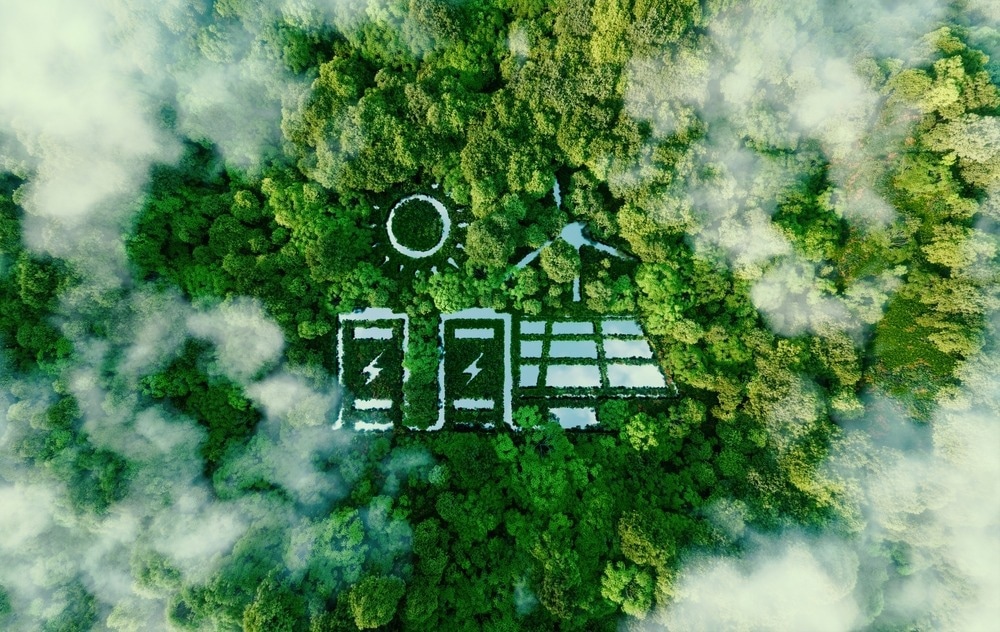
Image Credit: petrmalinak/Shutterstock.com
Green Hydrogen OverviewHydrogen synthesized by splitting water into oxygen and hydrogen using renewable electricity is called green hydrogen. Renewable energy ensures hydrogen produced is free from carbon emissions.
Green hydrogen is the most promising clean energy carrier of the low-carbon economy. Its combustion does not produce any greenhouse gas emissions. It can also be a storage medium for intermittent energies such as tidal, wind, and solar.
The fuel is easily transportable and can be burnt anywhere as it produces water as its byproduct.
Electrolysis for Producing Green HydrogenThe production of environmentally friendly hydrogen is the focus of several research groups. Electrolysis is the only viable method to produce green hydrogen on a large scale. In this method, water electrolyzers convert freshwater into hydrogen and oxygen gases.
Renewable energy sources power these electrolyzers to make the process environmentally friendly and long-lasting.
Photocatalysts are also used in solar-powered water-splitting systems; they absorb sunlight to split fresh water to synthesize green hydrogen.
The strain on freshwater sources
Green hydrogen production requires renewable energy and fresh water. However, the geographical mismatch between freshwater availability and renewables distribution provides a substantial obstacle to its production.
Freshwater is challenging to get for daily use in some regions of the world, let alone for electrolysis. Therefore, large-scale production of green hydrogen could strain scarce freshwater sources.
There have been attempts to synthesize hydrogen from salty and brackish waters to circumvent freshwater requirements, but the electrolysis devices struggle against pollution and chlorine byproducts.
Direct Air Electrolyzers for Green Hydrogen ProductionDr Gang Kevin Li and his colleagues developed a novel prototype air electrolyzer that uses renewable electricity to produce green hydrogen from moist air.
The prototype can function in 4% relative humidity dry air and synthesize more than 99% pure green hydrogen. Even in areas with limited access to fresh water on land, the device would enable the carbon-free production of hydrogen.
Globally, there are approximately 13 trillion tons of water in the atmosphere at any given time. Even Africa's arid regions, such as the Sahel region, have an average relative humidity of 20%.
To capture that humidity, the proposed device is composed of a sponge-like substance containing a hygroscopic liquid, which absorbs moisture from the air. The water molecules are then separated at electrodes into hydrogen and oxygen gases.
The electrolyzer was powered by a mini wind turbine and solar panels. Researchers tested the prototype inside and outside in the hot, dry summer.
For the outdoor testing, they linked five electrolyzers in parallel, which, when driven by the sun, generated 745 L of hydrogen m2 per day, sufficient to heat a house. The system has a solar-to-hydrogen efficiency of more than 15%.
The prototypes are relatively small, but the team hopes to develop 10 square meter units within the following year. The researchers believe the gadget might be beneficial in locations where liquid water for hydrogen production is not readily available.
Commercial Green Hydrogen Production from AirDesert Bloom Hydrogen, led by Aqua Aerem, is a commercial-scale project to synthesize renewable hydrogen using air for export and domestic markets. Aqua Aerem employs a unique technology to catch atmospheric water for electrolysis even in arid conditions.
The 10.75 USD billion project will produce green hydrogen for less than $2/kg by 2027 and export approximately 410,000 tons of green hydrogen when fully operational.
The project's competitive edge is its creative application of proven technology for commercial production of green hydrogen without depleting freshwater resources, which lowers the startup and ongoing costs of manufacturing green hydrogen.
Future of Green HydrogenHydrogen has been used in the industrial sector for a very long time. Since the 19th century, hydrogen gas has been utilized in spacecraft, airships, and fuel cars. The inevitable decarbonization of the global economy will increase the significance of hydrogen.
However, green hydrogen is still expensive, and its commercial production via electrolysis requires access to cheap renewable energy. Therefore, reducing the green hydrogen cost is crucial for adopting hydrogen fuel in the transportation and energy sectors.
To make green hydrogen economically viable globally, advancements in technology, favorable hydrogen policies, robust hydrogen infrastructure, and government rebates and subsidies are required.